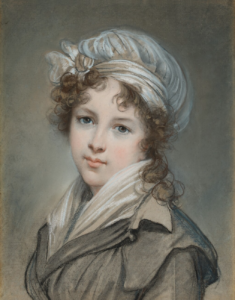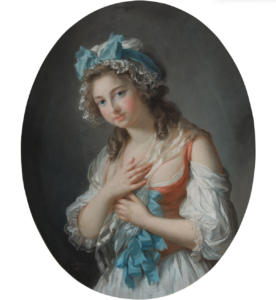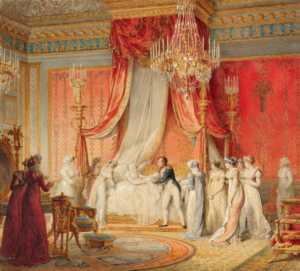
Self-Portrait in Traveling Costume by Élisabeth Louise Vigée Le Brun
On Wednesday, January 31st, both Christie’s and Sotheby’s hosted a series of sales centered on Old Masters. While these sales mostly did not perform as well as expected, the one exception was the first sale of the day, entitled A Scholar Collects. This sale was dedicated to the collection of Joseph Baillio, a prominent art historian and specialist in eighteenth-century French art. Baillio’s collection reflected his specialization, consisting mainly of sketches, drawings, and paintings by artists like Hubert Robert, Jean-Philippe-Guy Le Gentil, and, most importantly, Élisabeth Louise Vigée Le Brun.
Vigée Le Brun was a very important French artist of the eighteenth century and definitely one of the most prolific women in the arts at the time. She made a name for herself as a portraitist in the years before the Revolution of 1789. In her work, she often skirted the boundaries between the outgoing Baroque and Rococo and the incoming Neoclassical styles. Her skill led to her recognition by the French upper crust, including Queen Marie Antoinette, of whom Vigée Le Brun created around 30 portraits. However, she not only painted her aristocratic patrons but is now known for her many self-portraits, including the sale’s top lot, called Self-Portrait in Traveling Costume. This self-portrait, one of twelve lots by the artist included in the sale, was created in 1789, shortly before she fled Paris for Rome due to her ties to the queen. The inscription on the back is dated 1816 when the artist gifted the work to a man named Ménageot. This refers to François-Guillaume Ménageot, director of Rome’s Académie de France, who helped her find an apartment there. The portrait was, therefore, likely a gift to Ménageot when she returned to Paris. The self-portrait is in incredible condition and also serves as a priceless document for art historians with the inclusion of the inscription on the verso. Sotheby’s specialists, therefore, placed a $1 million high estimate on the portrait. With multiple bidders squabbling over the pastel-on-paper work, the final hammer price ended up at $2.5 million (or $3.1 million w/p). This makes it the second-most valuable work by the artist ever sold at auction, just behind Portrait of Muhammad Dervish Khan, which sold in 2019 for $7.2 million w/p.

Portrait of the Duchesse de Guiche by Élisabeth Louise Vigée Le Brun
The second place lot was also by Vigée Le Brun. Portrait of the Duchess of Guiche is a prime example of the artist’s work as the French nobility were her main patrons. Sotheby’s specialists remarked that the portrait is unique since the duchess’s clothes are somewhat unusual. Much of her clothing is made from gauze fabric and silk, which “accentuate more than they conceal”. According to Baillio, the subject’s clothing and pose may have been inspired by an earlier painting called The Broken Pitcher by Jean-Baptiste Greuze. The portrait hit the low end of its $500K to $700K estimate range (or $635K w/p).
For modern viewers, the sale’s third-place lot is a history painting. However, it was not so far in the distant past for the artist. Napoleon Presenting the Newborn King of Rome to Empress Marie Louise was painted in 1811 by Jean-Baptiste Isabey. A student of Jacques Louis David, Isabey came to prominence during the Napoleonic era and enjoyed the patronage of the imperial couple Napoleon and Joséphine. As I mentioned in an earlier article on Ridley Scott’s biopic Napoleon, the Emperor understood how to use art to craft his image. Isabey’s painting shows a likely idealized version of a momentous occasion for the French Empire: the birth of an heir. In 1810, Napoleon divorced Joséphine mainly due to her inability to have children, later marrying the Duchess of Parma, Marie Louise. In the painting, we see the aftermath of the birth of Napoleon’s son, who was given the titles Prince Imperial and King of Rome immediately upon his birth. For such a great occasion, Isabey also includes several prominent members of Napoleon’s family and household in the room. It is suspected that Isabey created this watercolor to mark the occasion as well as portray Napoleon in a far more sympathetic light as a kind, gentle new father. Like the Duchess of Guiche portrait, Isabey’s watercolor exactly hit its low estimate at $300K (or $381K w/p).

Napoléon Presenting the Newborn King of Rome to Empress Marie Louise by Jean-Baptiste Isabey
Now for the surprises: four lots sold for more than double their high estimates, including the first Vigée Le Brun work to cross the block, The Little Eugène de Montesquiou-Fézensac Asleep. Sotheby’s specialists called this and another infant portrait “some of the most tender and moving depictions of young children in French eighteenth-century art”. Estimated to sell for no more than $60K, the sleeping aristocrat made nearly three times that at $170K (or $215.9K w/p). However, the one lot that blew its estimate out of the water was an etching by Jean Godefroy. It is a copy of Isabey’s watercolor showing the Congress of Vienna in 1815. Here, Europe’s major power players planned out the continent’s new political order after Napoleon’s downfall. The etching shows several famous figures, including the Duke of Wellington, Charles Maurice de Talleyrand-Périgord (Napoleon’s former foreign minister), and Klemens von Metternich (chancellor of Austria). Expected to sell for no more than $1K, the group portrait sold when the hammer came down at $8.5K (or $10.8K w/p).
In the end, twelve of the forty-one lots sold within their estimates, giving Sotheby’s specialists a 29% accuracy rate. An additional four lots (10%) sold below their estimates, while an incredible seventeen (41%) sold above their estimates. The remaining eight lots (20%) went unsold. With so many lots selling far above their estimates, including the Vigée Le Brun self-portrait, the sale as a whole surpassed its total high estimate of $4,017,600, reaching $5,087,000.
Sotheby’s New York “A Scholar Collects” Sale
Self-Portrait in Traveling Costume by Élisabeth Louise Vigée Le Brun
On Wednesday, January 31st, both Christie’s and Sotheby’s hosted a series of sales centered on Old Masters. While these sales mostly did not perform as well as expected, the one exception was the first sale of the day, entitled A Scholar Collects. This sale was dedicated to the collection of Joseph Baillio, a prominent art historian and specialist in eighteenth-century French art. Baillio’s collection reflected his specialization, consisting mainly of sketches, drawings, and paintings by artists like Hubert Robert, Jean-Philippe-Guy Le Gentil, and, most importantly, Élisabeth Louise Vigée Le Brun.
Vigée Le Brun was a very important French artist of the eighteenth century and definitely one of the most prolific women in the arts at the time. She made a name for herself as a portraitist in the years before the Revolution of 1789. In her work, she often skirted the boundaries between the outgoing Baroque and Rococo and the incoming Neoclassical styles. Her skill led to her recognition by the French upper crust, including Queen Marie Antoinette, of whom Vigée Le Brun created around 30 portraits. However, she not only painted her aristocratic patrons but is now known for her many self-portraits, including the sale’s top lot, called Self-Portrait in Traveling Costume. This self-portrait, one of twelve lots by the artist included in the sale, was created in 1789, shortly before she fled Paris for Rome due to her ties to the queen. The inscription on the back is dated 1816 when the artist gifted the work to a man named Ménageot. This refers to François-Guillaume Ménageot, director of Rome’s Académie de France, who helped her find an apartment there. The portrait was, therefore, likely a gift to Ménageot when she returned to Paris. The self-portrait is in incredible condition and also serves as a priceless document for art historians with the inclusion of the inscription on the verso. Sotheby’s specialists, therefore, placed a $1 million high estimate on the portrait. With multiple bidders squabbling over the pastel-on-paper work, the final hammer price ended up at $2.5 million (or $3.1 million w/p). This makes it the second-most valuable work by the artist ever sold at auction, just behind Portrait of Muhammad Dervish Khan, which sold in 2019 for $7.2 million w/p.
Portrait of the Duchesse de Guiche by Élisabeth Louise Vigée Le Brun
The second place lot was also by Vigée Le Brun. Portrait of the Duchess of Guiche is a prime example of the artist’s work as the French nobility were her main patrons. Sotheby’s specialists remarked that the portrait is unique since the duchess’s clothes are somewhat unusual. Much of her clothing is made from gauze fabric and silk, which “accentuate more than they conceal”. According to Baillio, the subject’s clothing and pose may have been inspired by an earlier painting called The Broken Pitcher by Jean-Baptiste Greuze. The portrait hit the low end of its $500K to $700K estimate range (or $635K w/p).
For modern viewers, the sale’s third-place lot is a history painting. However, it was not so far in the distant past for the artist. Napoleon Presenting the Newborn King of Rome to Empress Marie Louise was painted in 1811 by Jean-Baptiste Isabey. A student of Jacques Louis David, Isabey came to prominence during the Napoleonic era and enjoyed the patronage of the imperial couple Napoleon and Joséphine. As I mentioned in an earlier article on Ridley Scott’s biopic Napoleon, the Emperor understood how to use art to craft his image. Isabey’s painting shows a likely idealized version of a momentous occasion for the French Empire: the birth of an heir. In 1810, Napoleon divorced Joséphine mainly due to her inability to have children, later marrying the Duchess of Parma, Marie Louise. In the painting, we see the aftermath of the birth of Napoleon’s son, who was given the titles Prince Imperial and King of Rome immediately upon his birth. For such a great occasion, Isabey also includes several prominent members of Napoleon’s family and household in the room. It is suspected that Isabey created this watercolor to mark the occasion as well as portray Napoleon in a far more sympathetic light as a kind, gentle new father. Like the Duchess of Guiche portrait, Isabey’s watercolor exactly hit its low estimate at $300K (or $381K w/p).
Napoléon Presenting the Newborn King of Rome to Empress Marie Louise by Jean-Baptiste Isabey
Now for the surprises: four lots sold for more than double their high estimates, including the first Vigée Le Brun work to cross the block, The Little Eugène de Montesquiou-Fézensac Asleep. Sotheby’s specialists called this and another infant portrait “some of the most tender and moving depictions of young children in French eighteenth-century art”. Estimated to sell for no more than $60K, the sleeping aristocrat made nearly three times that at $170K (or $215.9K w/p). However, the one lot that blew its estimate out of the water was an etching by Jean Godefroy. It is a copy of Isabey’s watercolor showing the Congress of Vienna in 1815. Here, Europe’s major power players planned out the continent’s new political order after Napoleon’s downfall. The etching shows several famous figures, including the Duke of Wellington, Charles Maurice de Talleyrand-Périgord (Napoleon’s former foreign minister), and Klemens von Metternich (chancellor of Austria). Expected to sell for no more than $1K, the group portrait sold when the hammer came down at $8.5K (or $10.8K w/p).
In the end, twelve of the forty-one lots sold within their estimates, giving Sotheby’s specialists a 29% accuracy rate. An additional four lots (10%) sold below their estimates, while an incredible seventeen (41%) sold above their estimates. The remaining eight lots (20%) went unsold. With so many lots selling far above their estimates, including the Vigée Le Brun self-portrait, the sale as a whole surpassed its total high estimate of $4,017,600, reaching $5,087,000.